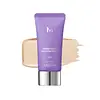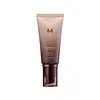What's inside
What's inside
 Key Ingredients
Key Ingredients

 Benefits
Benefits

 Concerns
Concerns

 Ingredients Side-by-side
Ingredients Side-by-side

Water
Skin ConditioningCyclopentasiloxane
EmollientCaprylic/Capric Triglyceride
MaskingTitanium Dioxide
Cosmetic ColorantGlycerin
HumectantButylene Glycol
HumectantPEG-10 Dimethicone
Skin ConditioningIron Oxides
Cetyl PEG/PPG-10/1 Dimethicone
EmulsifyingSynthetic Fluorphlogopite
Disteardimonium Hectorite
StabilisingMethyl Methacrylate Crosspolymer
Magnesium Sulfate
Pentylene Glycol
Skin ConditioningCI 77491
Cosmetic ColorantPalmitic Acid
EmollientTriethoxycaprylylsilane
CI 77499
Cosmetic ColorantGlyceryl Caprylate
EmollientCaprylyl Glycol
EmollientAluminum Hydroxide
EmollientCitrus Aurantium Bergamia Fruit Oil
MaskingEthylhexylglycerin
Skin ConditioningXanthan Gum
EmulsifyingPelargonium Graveolens Flower Oil
MaskingCitrus Aurantium Dulcis Peel Oil
MaskingLavandula Angustifolia Oil
MaskingMyristic Acid
CleansingStearic Acid
CleansingAnthemis Nobilis Flower Oil
MaskingTocopherol
AntioxidantSantalum Album Oil
Masking1,2-Hexanediol
Skin ConditioningBifida Ferment Lysate
Skin ConditioningLactobacillus Ferment
Skin ConditioningBifida Ferment Filtrate
Skin ConditioningLactococcus Ferment Lysate
Skin ConditioningLactobacillus Ferment Lysate
Skin ConditioningLactococcus Ferment
Skin ConditioningLeuconostoc/Radish Root Ferment Filtrate
AntimicrobialLactobacillus/Acerola Cherry Ferment
Skin ProtectingLactobacillus/Soybean Ferment Extract
Skin ConditioningLactobacillus/Punica Granatum Fruit Ferment Extract
Skin ConditioningOryza Sativa Extract
AbsorbentSaccharomyces Ferment
Skin ConditioningBeta Vulgaris Root Extract
Skin ConditioningDaucus Carota Sativa Root Extract
Skin ConditioningBrassica Oleracea Capitata Leaf Extract
Skin ConditioningVaccinium Angustifolium Fruit Extract
Skin ProtectingSolanum Melongena Fruit Extract
Skin ConditioningBacillus Ferment
Skin ConditioningWater, Cyclopentasiloxane, Caprylic/Capric Triglyceride, Titanium Dioxide, Glycerin, Butylene Glycol, PEG-10 Dimethicone, Iron Oxides, Cetyl PEG/PPG-10/1 Dimethicone, Synthetic Fluorphlogopite, Disteardimonium Hectorite, Methyl Methacrylate Crosspolymer, Magnesium Sulfate, Pentylene Glycol, CI 77491, Palmitic Acid, Triethoxycaprylylsilane, CI 77499, Glyceryl Caprylate, Caprylyl Glycol, Aluminum Hydroxide, Citrus Aurantium Bergamia Fruit Oil, Ethylhexylglycerin, Xanthan Gum, Pelargonium Graveolens Flower Oil, Citrus Aurantium Dulcis Peel Oil, Lavandula Angustifolia Oil, Myristic Acid, Stearic Acid, Anthemis Nobilis Flower Oil, Tocopherol, Santalum Album Oil, 1,2-Hexanediol, Bifida Ferment Lysate, Lactobacillus Ferment, Bifida Ferment Filtrate, Lactococcus Ferment Lysate, Lactobacillus Ferment Lysate, Lactococcus Ferment, Leuconostoc/Radish Root Ferment Filtrate, Lactobacillus/Acerola Cherry Ferment, Lactobacillus/Soybean Ferment Extract, Lactobacillus/Punica Granatum Fruit Ferment Extract, Oryza Sativa Extract, Saccharomyces Ferment, Beta Vulgaris Root Extract, Daucus Carota Sativa Root Extract, Brassica Oleracea Capitata Leaf Extract, Vaccinium Angustifolium Fruit Extract, Solanum Melongena Fruit Extract, Bacillus Ferment
Water
Skin ConditioningCI 77891
Cosmetic ColorantCyclopentasiloxane
EmollientDipropylene Glycol
HumectantPanax Ginseng Root Extract
EmollientPhenyl Trimethicone
Skin ConditioningButyloctyl Salicylate
Skin ConditioningCetyl PEG/PPG-10/1 Dimethicone
EmulsifyingButylene Glycol
HumectantCyclohexasiloxane
EmollientNiacinamide
SmoothingTalc
AbrasiveCalcium Stearate
Cosmetic ColorantMagnesium Sulfate
Sorbitan Sesquioleate
EmulsifyingCI 77492
Cosmetic ColorantTocopheryl Acetate
AntioxidantDimethicone
EmollientSynthetic Beeswax
Emulsion StabilisingAluminum Hydroxide
EmollientHydrogenated Polyisobutene
EmollientStearic Acid
CleansingPhenoxyethanol
PreservativeCaprylyl Glycol
EmollientCI 77491
Cosmetic ColorantGlycerin
HumectantTriethoxycaprylylsilane
Disteardimonium Hectorite
StabilisingCI 77499
Cosmetic ColorantSilica
AbrasiveAlcohol
Antimicrobial1,2-Hexanediol
Skin ConditioningDisodium EDTA
Triethyl Citrate
MaskingHydroxyethylcellulose
Emulsion StabilisingAdenosine
Skin ConditioningParfum
MaskingDimethicone Crosspolymer
Emulsion StabilisingEthylhexylglycerin
Skin ConditioningBeeswax
Emulsion StabilisingDimethicone/Vinyl Dimethicone Crosspolymer
Skin ConditioningCellulose
AbsorbentSodium Hyaluronate
HumectantPolymethylsilsesquioxane
CI 77480
Cosmetic ColorantBifida Ferment Lysate
Skin ConditioningCentella Asiatica Extract
CleansingLactose
HumectantSilica Silylate
EmollientPanthenol
Skin ConditioningDisodium Stearoyl Glutamate
CleansingDisodium Phosphate
BufferingPolysorbate 60
EmulsifyingMadecassoside
AntioxidantSodium Phosphate
BufferingButylphenyl Methylpropional
PerfumingBenzyl Benzoate
AntimicrobialWater, CI 77891, Cyclopentasiloxane, Dipropylene Glycol, Panax Ginseng Root Extract, Phenyl Trimethicone, Butyloctyl Salicylate, Cetyl PEG/PPG-10/1 Dimethicone, Butylene Glycol, Cyclohexasiloxane, Niacinamide, Talc, Calcium Stearate, Magnesium Sulfate, Sorbitan Sesquioleate, CI 77492, Tocopheryl Acetate, Dimethicone, Synthetic Beeswax, Aluminum Hydroxide, Hydrogenated Polyisobutene, Stearic Acid, Phenoxyethanol, Caprylyl Glycol, CI 77491, Glycerin, Triethoxycaprylylsilane, Disteardimonium Hectorite, CI 77499, Silica, Alcohol, 1,2-Hexanediol, Disodium EDTA, Triethyl Citrate, Hydroxyethylcellulose, Adenosine, Parfum, Dimethicone Crosspolymer, Ethylhexylglycerin, Beeswax, Dimethicone/Vinyl Dimethicone Crosspolymer, Cellulose, Sodium Hyaluronate, Polymethylsilsesquioxane, CI 77480, Bifida Ferment Lysate, Centella Asiatica Extract, Lactose, Silica Silylate, Panthenol, Disodium Stearoyl Glutamate, Disodium Phosphate, Polysorbate 60, Madecassoside, Sodium Phosphate, Butylphenyl Methylpropional, Benzyl Benzoate
 Reviews
Reviews

Ingredients Explained
These ingredients are found in both products.
Ingredients higher up in an ingredient list are typically present in a larger amount.
1,2-Hexanediol is a synthetic liquid and another multi-functional powerhouse.
It is a:
- Humectant, drawing moisture into the skin
- Emollient, helping to soften skin
- Solvent, dispersing and stabilizing formulas
- Preservative booster, enhancing the antimicrobial activity of other preservatives
Aluminum Hydroxide is a form of aluminum. It can be naturally found in nature as the mineral gibbsite. In cosmetics, Aluminum Hydroxide is used as a colorant, pH adjuster, and absorbent.
As a colorant, Aluminum Hydroxide may add opacity, or reduce the transparency. Aluminum hydroxide is contains both basic and acidic properties.
According to manufacturers, this ingredient is an emollient and humectant. This means it helps hydrate the skin.
In medicine, this ingredient is used to help relieve heartburn and help heal ulcers.
There is currently no credible scientific evidence linking aluminum hydroxide in cosmetics to increased cancer risk.
Major health organizations allow the use of aluminum hydroxide in personal care products and have not flagged it as a carcinogenic risk at typical usage levels.
Learn more about Aluminum HydroxideBifida Ferment Lysate is derived from the fermentation of Bifida bacteria (often with dairy). It is a probiotic and helps to strengthen our skin's microbiome.
Having a healthy microbiome helps protect our skin against infection. It also helps our skin stay hydrated and healthy.
Studies also show this ingredient to be a promising soothing ingredient for sensitive skin.
Learn more about Bifida Ferment LysateButylene Glycol (or BG) is used within cosmetic products for a few different reasons:
Overall, Butylene Glycol is a safe and well-rounded ingredient that works well with other ingredients.
Though this ingredient works well with most skin types, some people with sensitive skin may experience a reaction such as allergic rashes, closed comedones, or itchiness.
Learn more about Butylene GlycolCaprylyl Glycol is a humectant and emollient, meaning it attracts and preserves moisture.
It is a common ingredient in many products, especially those designed to hydrate skin. The primary benefits are retaining moisture, skin softening, and promoting a healthy skin barrier.
Though Caprylyl Glycol is an alcohol derived from fatty acids, it is not the kind that can dry out skin.
This ingredient is also used as a preservative to extend the life of products. It has slight antimicrobial properties.
Learn more about Caprylyl GlycolThis ingredient is a high molecular weight silicone. It has emulsifying and skin conditioning properties.
Ci 77491 is also hydrated iron III oxide. It's sole purpose is to give a red/pink hue to products.
Iron III oxides are classified as inorganic chemicals for coloring.
Synthetically created Ci 77491 is considered safer than those naturally found. This is because the synthetically created version may contain less impurities. Iron oxides are generally non-toxic and non-allergenic.
Learn more about CI 77491Ci 77499 is also hydrated iron III oxide. It is created from mixing red and black iron oxides. This helps give shades of darkness to a product.
Iron III oxides are classified as inorganic chemicals for coloring.
Cyclopentasiloxane, or D5, is a silicone used to improve texture of products and trap moisture.
D5 is considered lightweight and volatile. Volatile means it evaporates quickly after application. Once evaporated, D5 leaves a thin barrier that helps keep skin hydrated.
It is also an emollient. Emollients help soften the skin and prevent water loss. Silicones create a silky texture in products. D5 helps other ingredients become more spreadable.
Studies show D5 is safe to use in skincare products. We recommend speaking with a skincare professional if you have concerns.
Learn more about CyclopentasiloxaneDisteardimonium Hectorite comes from the clay mineral named hectorite. It is used to add thickness to a product.
It can also help stabilize a product by helping to disperse other ingredients.
Hectorite is a rare, white clay mineral.
Learn more about Disteardimonium HectoriteEthylhexylglycerin (we can't pronounce this either) is commonly used as a preservative and skin softener. It is derived from glyceryl.
You might see Ethylhexylglycerin often paired with other preservatives such as phenoxyethanol. Ethylhexylglycerin has been found to increase the effectiveness of these other preservatives.
Glycerin is already naturally found in your skin. It helps moisturize and protect your skin.
A study from 2016 found glycerin to be more effective as a humectant than AHAs and hyaluronic acid.
As a humectant, it helps the skin stay hydrated by pulling moisture to your skin. The low molecular weight of glycerin allows it to pull moisture into the deeper layers of your skin.
Hydrated skin improves your skin barrier; Your skin barrier helps protect against irritants and bacteria.
Glycerin has also been found to have antimicrobial and antiviral properties. Due to these properties, glycerin is often used in wound and burn treatments.
In cosmetics, glycerin is usually derived from plants such as soybean or palm. However, it can also be sourced from animals, such as tallow or animal fat.
This ingredient is organic, colorless, odorless, and non-toxic.
Glycerin is the name for this ingredient in American English. British English uses Glycerol/Glycerine.
Learn more about GlycerinMagnesium Sulfate is a salt. More specifically, it is an epsom salt, or the bath salt used to help relieve muscle aches.
Despite having ‘sulfate’ in the name, it isn’t a surfactant or cleansing agent like sodium lauryl sulfate. Unlike those sulfates, magnesium sulfate doesn’t have the same cleansing or foaming properties (it's simply a type of salt).
In cosmetics, Magnesium Sulfate is used to thicken a product or help dilute other solids. It is a non-reactive and non-irritating ingredient.
One study shows magnesium deficiency may lead to inflammation of the skin. Applying magnesium topically may help reduce inflammation.
You can find this ingredient in sea water or mineral deposits.
Learn more about Magnesium SulfateStearic Acid is a fatty acid. It is an emollient, emulsifier, and texture enhancer.
As an emollient, stearic acid helps soften skin. It aids the skin's protective barrier by preventing water loss. It also provides a gentle cleansing effect without stripping away natural oils.
Stearic acid may also be used to enhance the texture of products. It can add volume and stabilize ingredients such as water and oil. This can help water and oil ingredients from separating.
Sources of stearic acid include animal or vegetable fats/oils such as coconut or shea. It can be naturally found in butter, cocoa butter, shea butter, vegetable fats, and animal tallow.
This ingredient may not be Malassezia folliculitis, or fungal-acne safe.
Learn more about Stearic AcidTriethoxycaprylylsilane is a silicone used to bind and stabilize ingredients.
As an emulsifier, it helps prevent ingredients from separating. This can help elongate the shelf life of products.
Triethoxycaprylylsilane is often used to coat mineral sunscreens ingredients to help give a better feel. It also helps reduce oxidative stress in sunscreens.
Learn more about TriethoxycaprylylsilaneWater. It's the most common cosmetic ingredient of all. You'll usually see it at the top of ingredient lists, meaning that it makes up the largest part of the product.
So why is it so popular? Water most often acts as a solvent - this means that it helps dissolve other ingredients into the formulation.
You'll also recognize water as that liquid we all need to stay alive. If you see this, drink a glass of water. Stay hydrated!
Learn more about Water